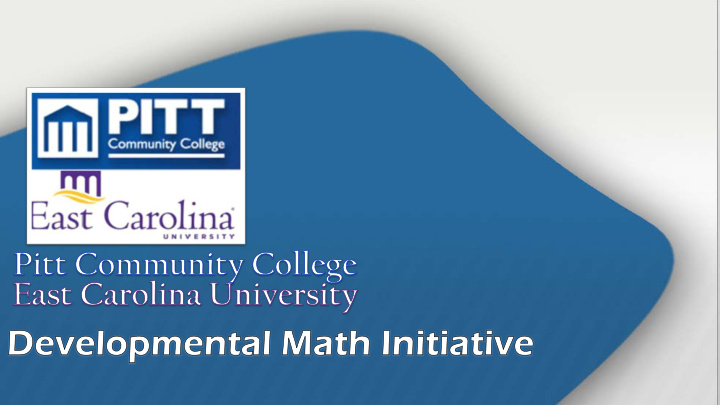



HISTORY In 1988, PCC and ECU develop MOU for ECU students in need of Developmental Math instruction (Math 045 course). Dual enrollment at PCC and ECU . FTE’s reported by PCC. PCC covers salaries and instructional costs. Classes held both online and on ECU campus. Self-paced learning in computer lab. Credit hours reflected on transcripts at both PCC and ECU . ECU charges “remediation fee”.
Business Model ECU receives “fee” to support overhead (facilities and academic support). PCC receives tuition and FTE credit to support instructor costs. Registrars coordinate enrollment . PCC registers students as Special Credit students . PCC transfers balance of student accounts to 3 rd party sponsor account (ECU). PCC invoices ECU for this amount. ECU sends payment for tuition to PCC.
INSTRUCTION , PERSONNEL AND ENROLLMENT Instruction Personnel Enrollment • Self-paced lab • Two full-time • In 2016, 38 sections sections (instructor/ instructors and five (spring, summer, fall). assistants). part-time instructors • In 2014-15, 800 • ECU Pirate Academic students enrolled in Success Center. program. • Fall 2016, 530 students enrolled. • 15% of Freshman ECU students in cohort.
PARTNERSHIP BENEFITS Course PCC faculty ECU does produces Supplied able to better not provide better- and Faculty and prepare or pay for prepared maintained institutional transfer instructors students to computer collaboration students to or succeed in lab enhanced. succeed after instructional college- provided. matriculation. materials. level classes.
STUDENT BENEFITS • Continue with other classes while improving Math skills. • Convenient online and campus classes-University experience. • Small class learning environment/individual attention. • Increased scores in post-course Placement Test and prepared to succeed in college-level Math. • Comparable success rates as students who placed directly into college-level Math.
STUDENT SUCCESS Math 1045 completion Success rate of students Since 2014, success rate rate: placing directly into of Math 1045 completers Math 1065: in Math 1065: 67% 70%-75% 77% Since 2014, success rate Success rate of students of Math 1045 completers placing directly into in Math 1066: Math 1066: 82% 80%
QUESTIONS?
Recommend
More recommend